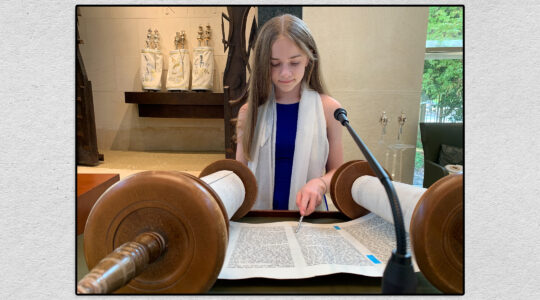If you glanced at my work calendar, you might not know that the world is turned inside out. As a cantor and rabbi at a Los Angeles synagogue, I am continuing to lead services and counsel congregants. But like so many others, all of my meetings have been commuted to digital platforms.
That shift has created new sets of dynamics in each virtual “room.” Some I anticipated, some surprised me.
Some dynamic shifts obviously are for the worse. Many of us are unpracticed at the art of teaching, learning and leading by digital means, at least on this global scale. We pride ourselves on how we usually walk into a room or step in front of a crowd with competence and confidence.
Sitting at my laptop, I find myself fumbling. Can I post a link to a Sefaria page here or get the right pdf of a siddur posted there? Whose microphone is squeaking, and is it OK for me to ask them to mute themselves for the 17th time?
In an age of chaos, the digital channels are often pathways to more chaos when all I want, for just 30 minutes, is at least the pretense of some composure.
We’re also disembodied by means of these online channels, and every meeting starts with some manner of attendance-taking that would be wholly unnecessary if we could just eyeball who was in the room. And it’s usually something like, “Who’s showing up as the initials BW, and by the way, do you want to lead Mincha?”
There’s an eerie quiet as we gather after Shabbat in the online space and hit the collective mute button, a digital hush that threatens the authenticity of even the sweetest moment of Havdalah as we train our eyes on the candle glowing at the corner of our screen. We even name these experiences as feeling far away: We call our homeschooling adventure “distance learning” because we feel, well, distant.
Despite this extended separation, I am experiencing a deeper intimacy in my interactions. When I logged on to our daily minyan for evening worship the first time, a thrill ran through me as face after face lit up the screen — each of us physically directed eastward but every one of us “panim el panim,” face to face in the Toraitic description of closeness.
Standing in a typical minyan room, we would be at least “arbah amot,” four cubits apart. In a physical space we would be at least six feet apart to be safe if legally gathered. In my living room, I can crowd my computer screen with 22 minyan-goers (best attendance in months!) safely, lovingly, intimately. It’s touching.
My default setting on Zoom videoconferencing is “active speaker” view, which means that the moment someone speaks in a meeting, their face fills my screen and my attention goes straight to their features. I find myself watching the contours of their head, their micro-expressions, their brief brow furrows and smirks. I’m able to listen with a deep connectedness to their full self in a way that’s transformational to my work and interpersonal relationships. There have been moments of matter-of-fact reporting among team members when I’ve watched anxiety and exhaustion flicker through the eyes of a colleague, and I’ve stopped to note that I should reach out.
And I watch myself watching myself — I watch my own face lose focus midway through a pastoral conversation. I self-correct, re-center and give myself over to the conversation.
I have more frequent pastoral conversations lately, more time set aside to sit with community members and tease through the tensions of the moment. The natural cascade of cancellations created an initial pileup of work that has now given way to a great pregnant pause in synagogue programming. In sacred partnership with my clergy team, I’m choosing to fill much of that vacuum with the kind of spiritual care giving that lets me slow down and spend substantive time listening to the angst of my congregants. B.C. (that is, “Before Covid-19”), I would have considered an hour of counseling over coffee, just for the sake of checking in, as the kind of generous time I could afford once a week at best. Now it’s a part of the fabric of my work, woven among everything I used to think of as “what cantors do.”
I remember an era long before FaceTime existed when someone described to me the eventuality of our being able to hold phones in the palm of our hand and speak to people around the world while looking into their eyes. There is no way I could have appreciated the dynamism made possible by virtual proximity, how intimacy could grow beyond tone and inflection when coupled with a face-to-face connection. And intimacy is precisely what I’m craving, and what I imagine so many others are craving, at a time where nearly nothing that’s intimate is permissive.
All sacred touch is in the category of restriction: the holding of a hand at a hospital bedside; the handshake on Shabbat evening; a hug at shiva; a hand wrapped around a dollar bill for tzedakah; baking challah for a friend. What a blessing that a screen can be an open window leading back to that holy corridor of intimacy.
True story: Last week, I was booted off our videoconference in the middle of leading weekday Maariv. This arrangement still feels glitchy, and I’m sure some of what I misattribute as inauthenticity is simply what I miss of my in-person experience. I miss our people, I miss our building and I miss tangible communal practice. I pray that health, normalcy and peace are soon restored to all of us.
But for as long as this lasts, I will not take for granted the intimate experience of looking someone in the eyes as I say amen to their Mourner’s Kaddish.
Hillary Chorny is a rabbi and cantor at Temple Beth Am in Los Angeles.
The New York Jewish Week brings you the stories behind the headlines, keeping you connected to Jewish life in New York. Help sustain the reporting you trust by donating today.




